Fiber Optic Cable
From: https://www.camplex.com/single-mode-and-multimode-fiber-cable
Fiber Optic Cables
How Light Travels Through the Fibers Determines the Features of Each Mode
How Does Fiber Optics Work?
As explained by the Fiber Optics Association, fiber optics is the
communications medium that sends optical signals down hair-thin strands of
extremely pure glass cores. The core is surrounded by the cladding that
traps the light in the core.
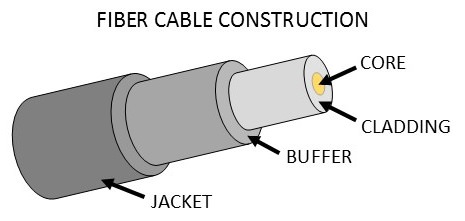 Fiber Cable Construction diagram
Fiber Cable Construction diagram
Core & Cladding Sizing
Fiber types are identified by the diameters of the core and cladding,
expressed in microns. Multimode fiber is available in two sizes, 62.5 or 50
microns, and four classifications: OM1 (62.5/125 µm), OM2, OM3, OM4
(50/125
µm). The diameter of a single mode core is 9µm. Both fiber types have a
cladding diameter of 125 µm or microns.
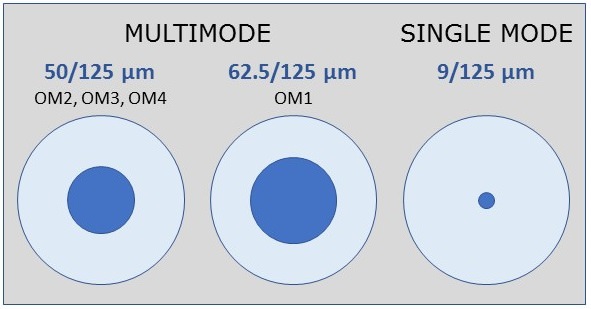 Fiber mode multimode and single mode diagram
Note: (from paul)
A µm or micro meter (AKA: micron) is distance measurement
and is .000001 meters long or .00003973"
1/125 of a µm is .000000314"
Fiber mode multimode and single mode diagram
Note: (from paul)
A µm or micro meter (AKA: micron) is distance measurement
and is .000001 meters long or .00003973"
1/125 of a µm is .000000314"
Single Mode Fiber
Single mode fiber has a much smaller core which forces the light to travel
in one ray or mode (a single mode) with little light reflection so the
signal will travel further.
Multimode Fiber
Light travels through a large core in many rays called modes (multiple
modes). Due to refraction, the rays are reflected from the cladding surface
back into the core as they move through the fiber.
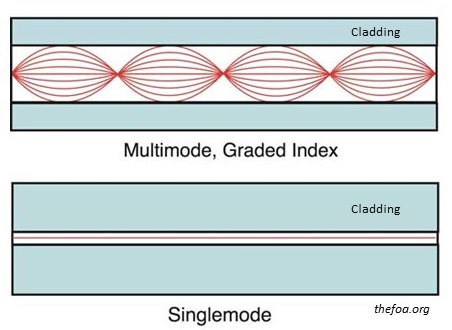 Fiber mode travel multimode graded index and single mode diagram
Your application requirements determine which mode you use. Refer to the
chart below for a comparison of the two modes.
Features Multimode Single Mode
Core/Cladding Size 50/125 μm or 62.5/125 μm 9/125 μm
Wavelengths 850 nm, 1300nm LED sources 1310nm, 1550nm Laser sources
Bandwidth Up to 4 GHZ Up to 100,000 GHZ
Distance (determined by cable, equipment & data protocol) Typically under
2km Typically over 2km
Benefits Less immune to contamination
Less expensive
Low cost sources Lower loss
High signal quality
High bandwidth
Applications Data centers, 10G, 40G, and 100G Ethernet protocols, MADI
digital audio, CCTV, security systems Long-haul networks, outside
broadcast, ENG crews, sporting and live events
Fiber mode travel multimode graded index and single mode diagram
Your application requirements determine which mode you use. Refer to the
chart below for a comparison of the two modes.
Features Multimode Single Mode
Core/Cladding Size 50/125 μm or 62.5/125 μm 9/125 μm
Wavelengths 850 nm, 1300nm LED sources 1310nm, 1550nm Laser sources
Bandwidth Up to 4 GHZ Up to 100,000 GHZ
Distance (determined by cable, equipment & data protocol) Typically under
2km Typically over 2km
Benefits Less immune to contamination
Less expensive
Low cost sources Lower loss
High signal quality
High bandwidth
Applications Data centers, 10G, 40G, and 100G Ethernet protocols, MADI
digital audio, CCTV, security systems Long-haul networks, outside
broadcast, ENG crews, sporting and live events
Multimode Fiber Types:
OM1 vs OM2 vs OM3 vs OM4 vs OM5
From: https://community.fs.com/blog/advantages-and-disadvantages-of
-multimode-fiber.html
John Updated on Sep 22, 2021 335.2k
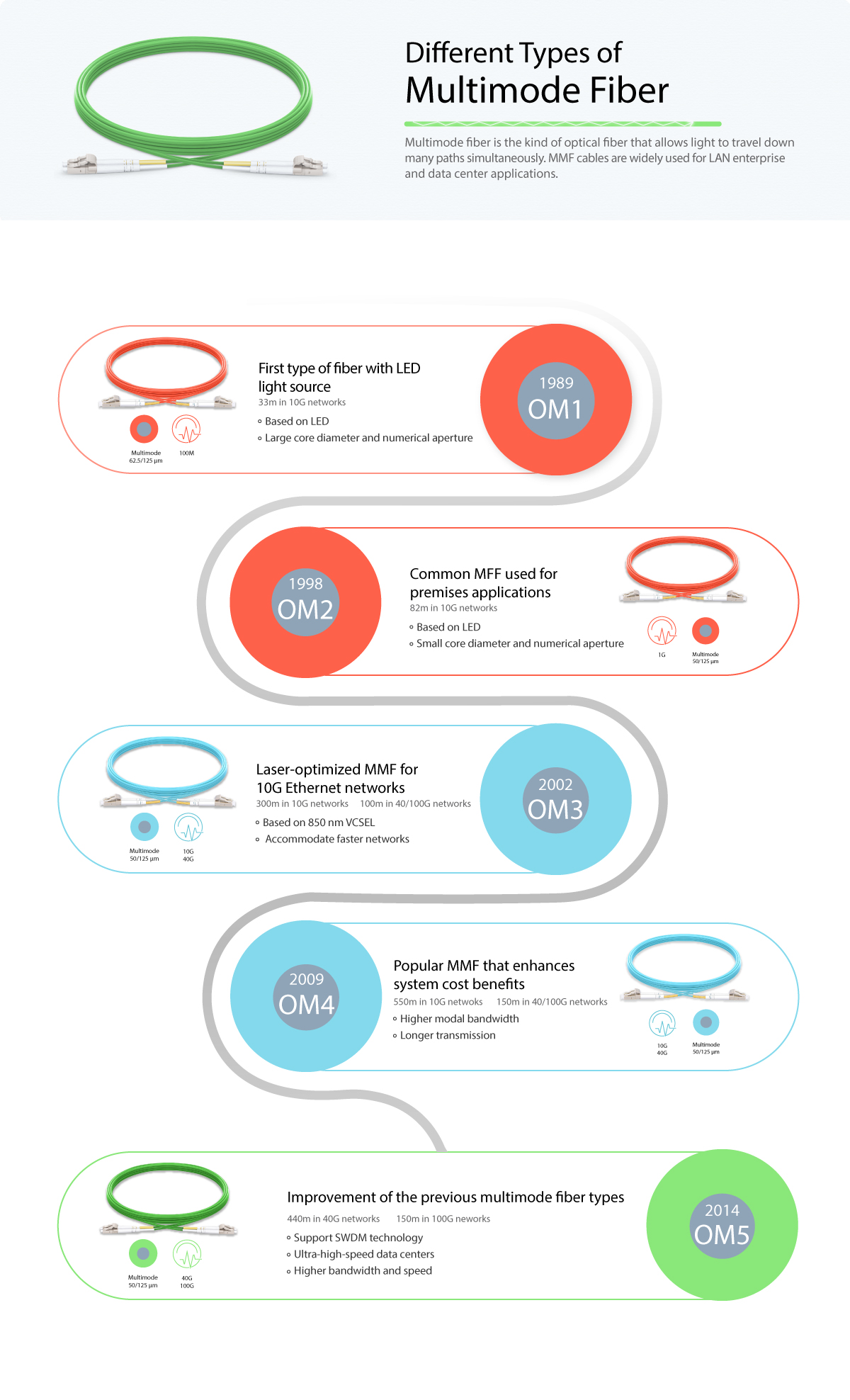 Multimode fiber is a common choice to achieve 10 Gbit/s speed over distances
required by LAN enterprise and data center applications. There are several kinds
of multimode fiber types available for high-speed network installations, and
each with a different reach and data-rate capability. With so many options, it
can be tough to select the most suitable multimode fiber. OM1 vs OM2 vs OM3 vs
OM4 vs OM5, which to choose? You may get answer in this article.
Multimode fiber is a common choice to achieve 10 Gbit/s speed over distances
required by LAN enterprise and data center applications. There are several kinds
of multimode fiber types available for high-speed network installations, and
each with a different reach and data-rate capability. With so many options, it
can be tough to select the most suitable multimode fiber. OM1 vs OM2 vs OM3 vs
OM4 vs OM5, which to choose? You may get answer in this article.
What Is Multimode Fiber?
Multimode fiber (MMF) is a kind of optical fiber mostly used in communication
over short distances, for example, inside a building or for the campus.
Multimode fiber optic cable has a larger core, typically 50 or 62.5 microns that
enables multiple light modes to be propagated. Because of this, more data can
pass through the multimode fiber core at a given time. The maximum transmission
distance for MMF cable is around 550m at the speed of 10Git/s. It can transmit
farther at lower data rates, such as going about 2km at 100Mb/s.
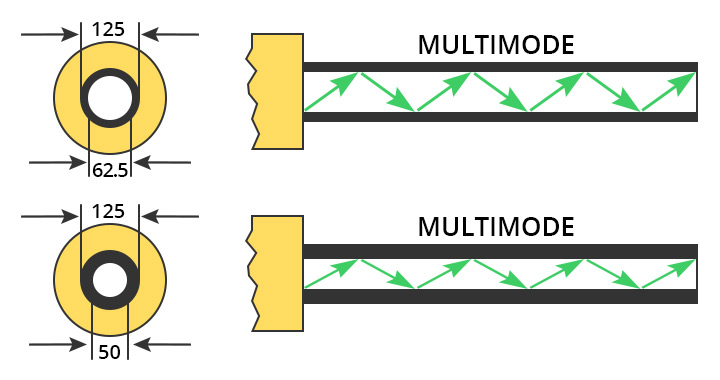 multimode fiber cable
multimode fiber cable
How Many Types of Multimode Fiber?
Identified by ISO 11801 standard, multimode fiber optic cables can be classified
into OM1 fiber, OM2 fiber, OM3 fiber, OM4 fiber and newly released OM5 fiber.
The next part will compare these fibers from the side of core size, bandwidth,
data rate, distance, color and optical source in details.
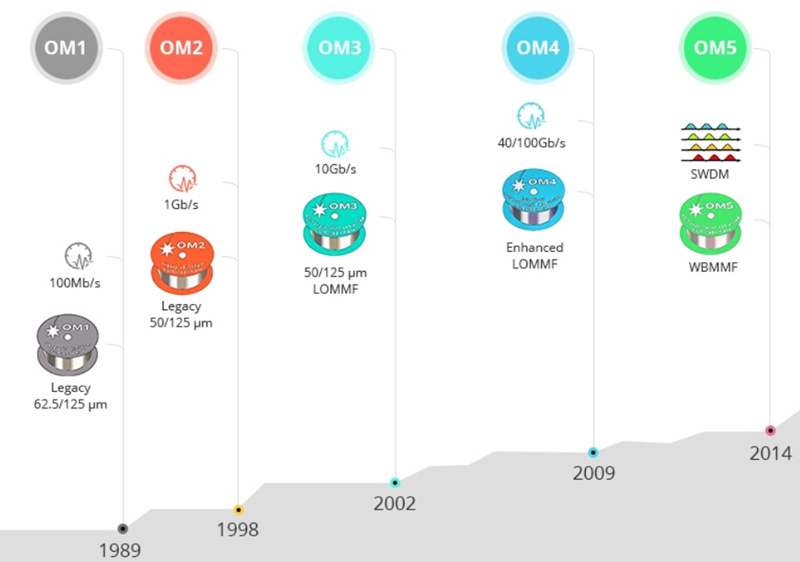 multimode fiber cable
multimode fiber cable
OM1 Fiber
OM1 fiber typically comes with an orange jacket and have a core size of 62.5 µm.
It can support 10 Gigabit Ethernet at lengths of up to 33 meters. It is most
commonly used for 100 Megabit Ethernet applications. This type commonly uses a
LED light source.
OM2 Fiber
Likewise, OM2 fiber also comes with an orange jacket and uses a LED light
source but with a smaller core size of 50 µm. It supports up to 10 Gigabit
Ethernet at lengths up to 82 meters but is more commonly used for 1 Gigabit
Ethernet applications.
OM3 Fiber
OM3 fiber comes with an aqua color jacket. Like the OM2, its core size is 50 µm,
but the cable is optimized for laser based equipment. OM3 supports 10 Gigabit
Ethernet at lengths up to 300 meters. Besides, OM3 is able to support 40 Gigabit
and 100 Gigabit Ethernet up to 100 meters, however, 10 Gigabit Ethernet is most
commonly used.
OM4 Fiber
OM4 fiber is completely backwards compatible with OM3 fiber and shares the same
distinctive aqua jacket. OM4 was developed specifically for VSCEL laser
transmission and allows 10 Gig/s link distances of up to 550m compared to 300M
with OM3. And it’s able to run 40/100GB up to 150 meters utilizing a MPO connector.
OM5 Fiber
OM5 fiber, also known as WBMMF (wideband multimode fiber), is the newest type of
multimode fiber, and it is backwards compatible with OM4. It has the same core
size as OM2, OM3, and OM4. The color of OM5 fiber jacket was chosen as lime
green. It is designed and specified to support at least four WDM channels at a
minimum speed of 28Gbps per channel through the 850-953 nm window. More details
can be found at: Three Critical Focuses on OM5 Fiber Optic Cable
OM1 vs OM2 vs OM3 vs OM4 vs OM5: What’s the Difference?
The prime distinction between multimode fibers rests on physical difference.
Accordingly, physical difference leads to different transmission data rate and
distance. Watch the following video to learn the differences between OM1, OM2,
OM3, OM4 & OM5 multimode fibers.
Physical Difference
Physical difference mainly lies in diameter, jacket color, optical source
and bandwidth, which is described in the following table.
| MMF Cable Type | Diameter | Jacket Color | Optical Source | Bandwidth
|
| OM1 | 62.5/125µm | Orange | LED | 200MHz*km
|
| OM2 | 50/125µm | Orange | LED | 500MHz*km
|
| OM3 | 50/125µm | Aqua | VSCEL | 2000MHz*km
|
| OM4 | 50/125µm | Aqua | VSCEL | 4700MHz*km
|
| OM5 | 50/125µm | Lime Green | VSCEL | 28000MHz*km
|
Practical Difference
Multimode fibers are able to transmit different distance ranges at various
data rate. You can choose the most suited one according to your actual
application. The max multimode fiber distance comparison at different data
rate is specified below.
| MMF Category | Fast Ethernet | 1GbE | 10GbE | 40GbE | 100GbE
|
| OM1 | 2000m | 275m | 33m | / | /
|
| OM2 | 2000m | 550m | 82m | / | /
|
| OM3 | 2000m | / | 300m | 100m | 70m
|
| OM4 | 2000m | / | 550m | 150m | 150m
|
| OM5 | / | / | 550m | 150m | 150m
|
What’s the Differences Between Single Mode and Multimode Fiber?
Technical difference
Core Diameter—Single mode fiber has a small diametral core(8.3 to 10
microns) that allows only one mode of light to propagate. Multimode fiber
optic cable has a large diametral core(50 to 100 microns) that allows
multiple modes of light to propagate.
Light Source—Multimode devices usually use a LED or laser as a light
source. While single mode devices use a laser, or laser diode, to produce
light injected into the cable.
Practical Difference 2
Distance—Light travels a longer distance inside single mode cable than it does
inside multimode. So multimode fiber is suitable for short haul application,
allowing transmission distances of up to about 550m at 10Git/s.
When distance is beyond 550m, single mode fiber is preferred.
Price—Multimode fiber usually cost less than single mode fiber.
Bandwidth—The bandwidth of single-mode is higher than multimode as much as
100,000 GHz.
Know more infro about single mode vs multimode fiber here: Single-mode Cabling
Cost vs. Multimode Cabling Cost
Multimode Fiber Connectors Types
There are many multimode fiber connector types in circulation such as ST, SC,
FC, LC, MU, E2000, MTRJ, SMA, DIN as well as MTP & MPO etc. The most
commonly used fiber optic connector types include ST, SC, FC and LC. Each one
has its own advantages, disadvantages, and capabilities. So what are the
differences and what do they mean to your implementation? This table of common
multimode fiber connectors gives an overview of strengths and weaknesses. Get
more details about commonly used fiber optic connectors here: Fiber Optic
Connector Types, Market, & Installation
| MMF Connector | Ferrule Size | Typical Insertion Loss (dB) | Cost(FS.com) | Application Features
|
| SC | φ2.5mm ceramic | 0.25-0.5 | US$ 0.65 | Mainstream, reliable, fast
deployment, filed fit
|
| LC | φ1.25mm ceramic | 0.25-0.5 | US$ 0.78 | High density, cost
-effective,filed fit
|
| FC | φ2.5mm ceramic | 0.25-0.5 | US$ 0.74 | High precision, vibration
environment, field fit
|
| ST | φ2.5mm ceramic | 0.25-0.5 | US$ 0.61 | Military, filed fit
|
What’s The Advantages of Multimode Fiber?
Although single mode fiber patch cable is advantageous in terms of bandwidth
and reach for longer distances, multimode fiber easily supports most
distances required for enterprise and data center networks at a cost
dramatically less than single mode fiber. Besides, multimode fiber optic
cable still has many significant advantages.
Multi-user Framework Without Loss Interference
Multimode fiber features carrying multiple signals at the same time in the same
line. Most importantly, the total power inside the signals carries almost no
loss. Therefore, the network user can send more than one packet in the cable at
the same time, and all information will be delivered to their destination with
out any interference and keep unchanged.
Support of Multiple Protocols
Multimode fiber can support many data transfer protocol, including Ethernet,
Infiniband, and Internet protocols. Therefore, one can use the cable as the
back bone of a series of high value applications.
Cost-effective
With a larger fiber core and good alignment tolerances, multimode fiber and
components are less expensive and are easier to work with other optical
components like fiber connector and fiber adapter, and multimode patch cords are
less expensive to operate, install and maintain than single mode fiber cables.
Conclusion
Due to its high capacity and reliability, multimode fiber is usually used for
backbone applications in buildings. In general, mmf cable continues to be the
most cost-effective choice for enterprise and data center applications up to the
500-600 meter range. But it’s not to say that we can substitute single mode
fiber with multimode fiber cable, as for whether to choose a single mode fiber
patch cord or multimode patch cord, it all depends on applications that you
need, transmission distance to be covered as well as the overall budget allowed.
Related Article: Single Mode Fiber: How Much Do You Know?
# Network Cabling and Wiring
# Fiber Patch Cords
What is WDM Fiber
What is WDM or DWDM?
From: https://www.ciena.com/insights/what-is/What-Is-WDM.html
Wavelength Division Multiplexing (WDM) is a fiber-optic transmission
technique that enables the use of multiple light wavelengths (or colors) to
send data over the same medium. Two or more colors of light can travel on
one fiber, and several signals can be transmitted in an optical waveguide at
differing wavelengths or frequencies on the optical spectrum.
|
|
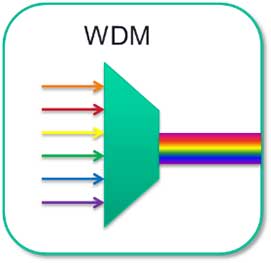 Diagram of WDM waves
Diagram of WDM waves
|
Early fiber-optic transmission systems put information onto strands of glass
through simple pulses of light. A light was flashed on and off to represent
digital ones and zeros. The actual light could be of almost any
wavelength—from roughly 670 nanometers to 1550 nanometers. Wavelength
Division Multiplexing, or WDM, is a technique in fiber-optic transmission
that uses multiple light wavelengths to send data over the same medium.
|
During the 1980s, fiber-optic data communications modems used low-cost LEDs
to put near-infrared pulses onto low-cost fiber. As the need for information
increased, so did the need for bandwidth. Early SONET systems used 1310
nanometer lasers to deliver 155 Mb/s data streams over very long distances.
But this capacity was quickly exhausted. Over time, advances in
optoelectronic components allowed the design of systems that simultaneously
transmitted multiple wavelengths of light over a single fiber, significantly
increasing fiber capacity. Thus, WDM was born. Multiple high-bit-rate data
streams of 10 Gb/s, 40 Gb/s, 100 Gb/s, 200 Gb/s and more recently, 400 Gb/s
and 800 Gb/s, each carrying distinct throughputs, can be multiplexed over a
single fiber.
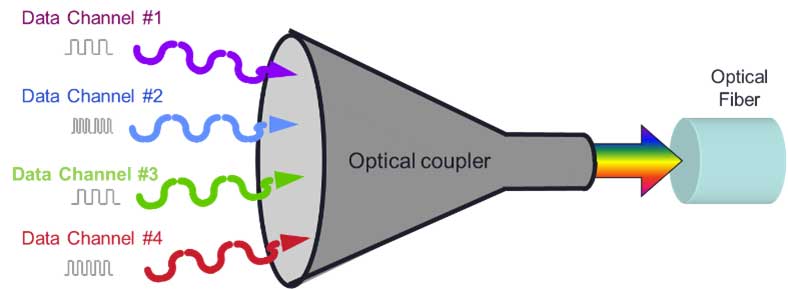 Diagram of the flow of data in an optical coupler
Diagram of the flow of data in an optical coupler
There are two types of WDM today:
- Coarse WDM (CWDM): CWDM is defined by WDM systems with fewer than eight
active wavelengths per fiber. CWDM is used for short-range communications,
so it employs wide-range frequencies with wavelengths that are spread far
apart. Standardized channel spacing permits room for wavelength drift as
lasers heat up and cool down during operation. CWDM is a compact and cost
-effective option when spectral efficiency is not an important requirement.
- Dense WDM (DWDM): DWDM is defined in terms of frequencies. DWDM’s
tighter wavelength spacing fits more channels onto a single fiber, but costs
more to implement and operate. DWDM is for systems with more than eight
active wavelengths per fiber. DWDM dices spectrum finely, fitting 40-plus
channels into the C-band frequency range.
Brochure
WaveLogic Photonics: Increasing Competitive Advantage with a Fully
Instrumented, Agile Photonic System
With DWDM, vendors have found various techniques for cramming 40, 88, or 96
wavelengths of fixed spacing into the C-band spectrum of a fiber.
Traditional DWDM line systems use Wavelength Selective Switches (WSS)
designed with fixed 50GHz or 100GHz filters. These fixed-grid line systems
can accommodate channels from early generations of coherent transponders
whose wavelengths require less than 50GHz or 100GHz of spectrum (depending
on the filter used). Today, networks with high- bandwidth applications and
sustained bandwidth growth that are quickly facing capacity exhaustion are
turning to C+L-band solutions, which also leverage the L-band spectrum of a
fiber to potentially double the fiber capacity.
 Diagram of an electromagnetic spectrum
As optical networks evolve to meet today’s ever-increasing bandwidth
demands, so has the dependence on next-generation programmable coherent
technology to maximize fiber capacity and lower the cost per bit of
transport. To fully take advantage of these benefits requires a flexible
-grid line system that can accommodate these higher-baud channels, such as
an 800G wavelength, that require more than 100GHz of spectrum.
Diagram of an electromagnetic spectrum
As optical networks evolve to meet today’s ever-increasing bandwidth
demands, so has the dependence on next-generation programmable coherent
technology to maximize fiber capacity and lower the cost per bit of
transport. To fully take advantage of these benefits requires a flexible
-grid line system that can accommodate these higher-baud channels, such as
an 800G wavelength, that require more than 100GHz of spectrum.
WDM is a technique in fiber optic transmission for using multiple light
wavelengths to send data over the same medium.
In fact, today’s next-generation coherent modems are so intelligent and
programmable that the modem considers a greater variety of constellation and
baud options, enabling extremely granular tunability. Today, flexible
channel plans are possible, enabling anything from 64 x 75GHz channels or 40
-45 channels for higher, 800G line rates—leveraging a flexible grid (or
gridless) architecture that supports channels with a minimum size of
37.5GHz, with adjustable increments of 6.25GHz—to accommodate any channel
available today or in the future.
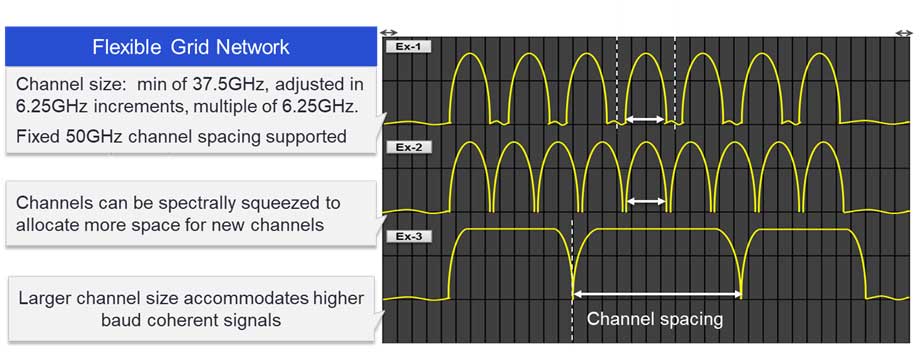 Diagram of flex grid network showing channel spacing
When boosted by Erbium Doped-Fiber Amplifiers (EDFAs) and Raman
amplification—two performance-enhancing technologies for high-speed
communications—the reach of these DWDM systems can be extended to work
over thousands of kilometers. For robust operation of a system with densely
packed channels, high-precision filters are required to peel away a specific
wavelength without interfering with neighboring wavelengths. DWDM systems
must also use precision lasers that operate at a constant temperature to
keep channels on target.
One of the best features of deploying DWDM over a flexible grid photonic
line system is signal independence—the ability to support multiple
generations of transponders independent of format, bit rate, symbol rate,
etc. As such, many networks designed for 10 and 40 Gb/s are now carrying 200
Gb/s channels, and many that were deployed with flexible grid capability are
now carrying 400 Gb/s and even 800 Gb/s signals!
Ciena offers the full breadth DWDM solutions to address customer
requirements, from the edge to the core, over a flexible range of platforms.
Ciena’s 6500 Family, Waveserver Family, and Routing and Switching
portfolio of 51xx and 81xx platforms leverage programmable WaveLogic
coherent technology across integrated hardware modules, as well as pluggable
coherent optics.
Subscribe to get more articles on this topic
As an example, Ciena’s popular 6500 Packet-Optical Platform leverages the
latest technology innovation to deliver new levels of scale, flexibility,
and programmability across three comprehensive networking layers for
customizable service delivery over any distance. Built for efficient network
scaling from the access to the backbone core, the 6500 provides technology
-leading programmable infrastructure that enables the software control,
automation, and intelligence required for a more adaptive network. It offers
the full gamut of CWDM and DWDM solutions across a fully agile, instrumented
photonic system, including support for flexible grid CDC ROADMs, with DWDM
solutions ranging from 10 Gb/s to 800 Gb/s.
Diagram of flex grid network showing channel spacing
When boosted by Erbium Doped-Fiber Amplifiers (EDFAs) and Raman
amplification—two performance-enhancing technologies for high-speed
communications—the reach of these DWDM systems can be extended to work
over thousands of kilometers. For robust operation of a system with densely
packed channels, high-precision filters are required to peel away a specific
wavelength without interfering with neighboring wavelengths. DWDM systems
must also use precision lasers that operate at a constant temperature to
keep channels on target.
One of the best features of deploying DWDM over a flexible grid photonic
line system is signal independence—the ability to support multiple
generations of transponders independent of format, bit rate, symbol rate,
etc. As such, many networks designed for 10 and 40 Gb/s are now carrying 200
Gb/s channels, and many that were deployed with flexible grid capability are
now carrying 400 Gb/s and even 800 Gb/s signals!
Ciena offers the full breadth DWDM solutions to address customer
requirements, from the edge to the core, over a flexible range of platforms.
Ciena’s 6500 Family, Waveserver Family, and Routing and Switching
portfolio of 51xx and 81xx platforms leverage programmable WaveLogic
coherent technology across integrated hardware modules, as well as pluggable
coherent optics.
Subscribe to get more articles on this topic
As an example, Ciena’s popular 6500 Packet-Optical Platform leverages the
latest technology innovation to deliver new levels of scale, flexibility,
and programmability across three comprehensive networking layers for
customizable service delivery over any distance. Built for efficient network
scaling from the access to the backbone core, the 6500 provides technology
-leading programmable infrastructure that enables the software control,
automation, and intelligence required for a more adaptive network. It offers
the full gamut of CWDM and DWDM solutions across a fully agile, instrumented
photonic system, including support for flexible grid CDC ROADMs, with DWDM
solutions ranging from 10 Gb/s to 800 Gb/s.
 Fiber Cable Construction diagram
Fiber Cable Construction diagram
 Fiber mode multimode and single mode diagram
Note: (from paul)
A µm or micro meter (AKA: micron) is distance measurement
and is .000001 meters long or .00003973"
1/125 of a µm is .000000314"
Fiber mode multimode and single mode diagram
Note: (from paul)
A µm or micro meter (AKA: micron) is distance measurement
and is .000001 meters long or .00003973"
1/125 of a µm is .000000314"
 Fiber mode travel multimode graded index and single mode diagram
Your application requirements determine which mode you use. Refer to the
chart below for a comparison of the two modes.
Features Multimode Single Mode
Core/Cladding Size 50/125 μm or 62.5/125 μm 9/125 μm
Wavelengths 850 nm, 1300nm LED sources 1310nm, 1550nm Laser sources
Bandwidth Up to 4 GHZ Up to 100,000 GHZ
Distance (determined by cable, equipment & data protocol) Typically under
2km Typically over 2km
Benefits Less immune to contamination
Less expensive
Low cost sources Lower loss
High signal quality
High bandwidth
Applications Data centers, 10G, 40G, and 100G Ethernet protocols, MADI
digital audio, CCTV, security systems Long-haul networks, outside
broadcast, ENG crews, sporting and live events
Fiber mode travel multimode graded index and single mode diagram
Your application requirements determine which mode you use. Refer to the
chart below for a comparison of the two modes.
Features Multimode Single Mode
Core/Cladding Size 50/125 μm or 62.5/125 μm 9/125 μm
Wavelengths 850 nm, 1300nm LED sources 1310nm, 1550nm Laser sources
Bandwidth Up to 4 GHZ Up to 100,000 GHZ
Distance (determined by cable, equipment & data protocol) Typically under
2km Typically over 2km
Benefits Less immune to contamination
Less expensive
Low cost sources Lower loss
High signal quality
High bandwidth
Applications Data centers, 10G, 40G, and 100G Ethernet protocols, MADI
digital audio, CCTV, security systems Long-haul networks, outside
broadcast, ENG crews, sporting and live events
 Multimode fiber is a common choice to achieve 10 Gbit/s speed over distances
required by LAN enterprise and data center applications. There are several kinds
of multimode fiber types available for high-speed network installations, and
each with a different reach and data-rate capability. With so many options, it
can be tough to select the most suitable multimode fiber. OM1 vs OM2 vs OM3 vs
OM4 vs OM5, which to choose? You may get answer in this article.
Multimode fiber is a common choice to achieve 10 Gbit/s speed over distances
required by LAN enterprise and data center applications. There are several kinds
of multimode fiber types available for high-speed network installations, and
each with a different reach and data-rate capability. With so many options, it
can be tough to select the most suitable multimode fiber. OM1 vs OM2 vs OM3 vs
OM4 vs OM5, which to choose? You may get answer in this article.
 multimode fiber cable
multimode fiber cable
 multimode fiber cable
multimode fiber cable
 Diagram of WDM waves
Diagram of WDM waves
 Diagram of the flow of data in an optical coupler
Diagram of the flow of data in an optical coupler
 Diagram of an electromagnetic spectrum
As optical networks evolve to meet today’s ever-increasing bandwidth
demands, so has the dependence on next-generation programmable coherent
technology to maximize fiber capacity and lower the cost per bit of
transport. To fully take advantage of these benefits requires a flexible
-grid line system that can accommodate these higher-baud channels, such as
an 800G wavelength, that require more than 100GHz of spectrum.
Diagram of an electromagnetic spectrum
As optical networks evolve to meet today’s ever-increasing bandwidth
demands, so has the dependence on next-generation programmable coherent
technology to maximize fiber capacity and lower the cost per bit of
transport. To fully take advantage of these benefits requires a flexible
-grid line system that can accommodate these higher-baud channels, such as
an 800G wavelength, that require more than 100GHz of spectrum.
 Diagram of flex grid network showing channel spacing
When boosted by Erbium Doped-Fiber Amplifiers (EDFAs) and Raman
amplification—two performance-enhancing technologies for high-speed
communications—the reach of these DWDM systems can be extended to work
over thousands of kilometers. For robust operation of a system with densely
packed channels, high-precision filters are required to peel away a specific
wavelength without interfering with neighboring wavelengths. DWDM systems
must also use precision lasers that operate at a constant temperature to
keep channels on target.
One of the best features of deploying DWDM over a flexible grid photonic
line system is signal independence—the ability to support multiple
generations of transponders independent of format, bit rate, symbol rate,
etc. As such, many networks designed for 10 and 40 Gb/s are now carrying 200
Gb/s channels, and many that were deployed with flexible grid capability are
now carrying 400 Gb/s and even 800 Gb/s signals!
Ciena offers the full breadth DWDM solutions to address customer
requirements, from the edge to the core, over a flexible range of platforms.
Ciena’s 6500 Family, Waveserver Family, and Routing and Switching
portfolio of 51xx and 81xx platforms leverage programmable WaveLogic
coherent technology across integrated hardware modules, as well as pluggable
coherent optics.
Subscribe to get more articles on this topic
As an example, Ciena’s popular 6500 Packet-Optical Platform leverages the
latest technology innovation to deliver new levels of scale, flexibility,
and programmability across three comprehensive networking layers for
customizable service delivery over any distance. Built for efficient network
scaling from the access to the backbone core, the 6500 provides technology
-leading programmable infrastructure that enables the software control,
automation, and intelligence required for a more adaptive network. It offers
the full gamut of CWDM and DWDM solutions across a fully agile, instrumented
photonic system, including support for flexible grid CDC ROADMs, with DWDM
solutions ranging from 10 Gb/s to 800 Gb/s.
Diagram of flex grid network showing channel spacing
When boosted by Erbium Doped-Fiber Amplifiers (EDFAs) and Raman
amplification—two performance-enhancing technologies for high-speed
communications—the reach of these DWDM systems can be extended to work
over thousands of kilometers. For robust operation of a system with densely
packed channels, high-precision filters are required to peel away a specific
wavelength without interfering with neighboring wavelengths. DWDM systems
must also use precision lasers that operate at a constant temperature to
keep channels on target.
One of the best features of deploying DWDM over a flexible grid photonic
line system is signal independence—the ability to support multiple
generations of transponders independent of format, bit rate, symbol rate,
etc. As such, many networks designed for 10 and 40 Gb/s are now carrying 200
Gb/s channels, and many that were deployed with flexible grid capability are
now carrying 400 Gb/s and even 800 Gb/s signals!
Ciena offers the full breadth DWDM solutions to address customer
requirements, from the edge to the core, over a flexible range of platforms.
Ciena’s 6500 Family, Waveserver Family, and Routing and Switching
portfolio of 51xx and 81xx platforms leverage programmable WaveLogic
coherent technology across integrated hardware modules, as well as pluggable
coherent optics.
Subscribe to get more articles on this topic
As an example, Ciena’s popular 6500 Packet-Optical Platform leverages the
latest technology innovation to deliver new levels of scale, flexibility,
and programmability across three comprehensive networking layers for
customizable service delivery over any distance. Built for efficient network
scaling from the access to the backbone core, the 6500 provides technology
-leading programmable infrastructure that enables the software control,
automation, and intelligence required for a more adaptive network. It offers
the full gamut of CWDM and DWDM solutions across a fully agile, instrumented
photonic system, including support for flexible grid CDC ROADMs, with DWDM
solutions ranging from 10 Gb/s to 800 Gb/s.